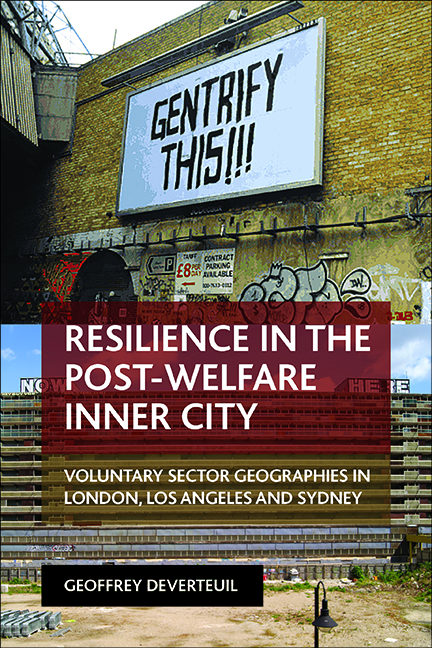 Resilience in the Post-Welfare Inner City
Resilience in the Post-Welfare Inner City Book contents
- Frontmatter
- Dedication
- Contents
- List of tables and figures
- About the author
- Acknowledgements
- Preface
- Part One Introducing resilience in the post-welfare inner city: conceptual and methodological considerations
- Part Two Case studies: spatial and social resilience in London, Los Angeles and Sydney
- Part Three Conclusions, critical resilience, commons and austerity
- References
- Index
eight - Pioneer gentrified place-types
Published online by Cambridge University Press: 10 March 2022
- Frontmatter
- Dedication
- Contents
- List of tables and figures
- About the author
- Acknowledgements
- Preface
- Part One Introducing resilience in the post-welfare inner city: conceptual and methodological considerations
- Part Two Case studies: spatial and social resilience in London, Los Angeles and Sydney
- Part Three Conclusions, critical resilience, commons and austerity
- References
- Index
Summary
Here I consider voluntary-sector resilience for two areas with relatively low and recent levels of gentrification, combined with traditionally very dense and robust residuals of voluntary organisations: Downtown and Hollywood, both in inner-city Los Angeles. Both areas featured high proportions of minority populations and measures that criminalised the poor (or at least contained and put them under surveillance), but also by far the highest levels of voluntary organisations per capita, with Downtown having an astounding 14 organisations per 1,000 persons, and Hollywood with 3.77 organisations per 1,000 persons. As interviews with the dozen emergency facilities emphasised, the Downtown service hub – focused on Skid Row – had become so large, dense, vested and publicly funded over such a long period that it would be a gross waste of taxpayers’ money to dismantle it. Rather, the public strategy has been to compress it and gradually erode its sharp boundaries, particularly on its western and northern (gentrifying) edges (DeVerteuil, 2012). So the very conspicuousness of Skid Row's clustering of homeless facilities mitigated against its wholesale displacement; another reason may also be that Downtown's ‘weak centre’ gentrification and weak centrality was simply not strong enough to overcome 30-odd years of actively entrenched voluntary-sector community resilience (Reese et al, 2010). A contrasting example is given by Hollywood, where resilience was more politically supported in the form of amenable policies that made the retention (rather than erosion/displacement) of voluntary-sector organisations a priority. But, for both cases, there was a sense of ultra-marginal, frontier space (as in Southwark) being targeted by pioneer gentrification, with striking though never overwhelming parallels to Smith's (1996) account of early gentrification in the Lower East Side. In particular, Skid Row, with its large street population, dense service geography and flophouses (there is even a ‘Frontier Hotel’), and purported criminality, remains the epitome of frontier space – but, even here, the forces of punitive gentrification, and the resilient and supportive responses to them were nowhere near as clearcut, predominant or even applicable as Smith portrayed them in 1990s New York.
A few words of background on Los Angeles gentrification are necessary before the two case studies are presented.
- Type
- Chapter
- Information
- Resilience in the Post-Welfare Inner CityVoluntary Sector Geographies in London, Los Angeles and Sydney, pp. 149 - 172Publisher: Bristol University PressPrint publication year: 2015


